Thermo Fisher Scientific VetMAX European BTV Typing Kit Operating instructions
- Type
- Operating instructions

For Veterinary Use Only. For In Vitro Use Only.
INSTRUCTIONS FOR USE
VetMAX™ European BTV Typing Kit
Real-time RT-PCR TaqMan™ for detection of BTV (Bluetongue Virus) types 1, 2, 4, 6, 8, 9, 11, and 16
Catalog Number BTVEUG
Doc. Part No. 100020321 Pub. No. MAN0008711 Rev. B.0
Technology
Species Nucleic acid isolated from matrices Test type
Real-time RT-PCR (RNA)
– 8 duplex reactions
– Endogenous IPC
Bovines
Small ruminants
(sheep, goat)
Blood (in EDTA tubes)
Spleen
Organs from aborted animals (spleen, liver, heart)
Individual
WARNING! Read the Safety Data Sheets (SDSs) and follow the handling instructions. Wear appropriate protective eyewear,
clothing, and gloves. Safety Data Sheets (SDSs) are available from thermofisher.com/support.
WARNING! POTENTIAL BIOHAZARD. Read the biological hazard safety information at this product’s page at
thermofisher.com. Wear appropriate protective eyewear, clothing, and gloves.
Information about the product
Description of the product
Bluetongue is a non-contagious, insect-borne infectious disease in sheep, included on the A list of the International Office of Epizootics.
It is caused by infection with the Bluetongue virus (BTV), a virus in the Reoviridae family, Orbivirus genus. To date, 27 different BTV
serotypes have been identified.
BTV is considered dangerous primarily for sheep; it leads to major morbidity and high mortality. BTV is the cause of clinical disease in
sheep; the virus also infects cattle, goats and other wild ruminants, but only exceptionally leads to clinical manifestations in those
species (Lefèvre & Desoutter, 1998).
The virus is nearly always transmitted by the infectious bite of a small, blood-sucking fly belonging to the Ceratopogonidae family,
Culicoides genus. There are more than 1400 species of Culicoides, but not all can transmit the virus. The vector is infected by feeding on
the blood of an infected animal, then reproduces the virus until a sufficient dose is obtained for transmission to other receptive animals.
The Applied Biosystems™ VetMAX™ European BTV Typing Kit is a BTV molecular diagnostic tool. This is a second-line kit that, after
BTV analysis of the positive group, enables specific detection of BTV1, BTV2, BTV4, BTV6, BTV8, BTV9, BTV11 and BTV16 virus typing
through the RT-PCR technology in real time.
Each RNA sample obtained after extraction is analyzed in a single well: the same well is used to specifically detect the viral RNA of
each type of BTV and to detect an IPC (Internal Positive Control). A positive IPC reflects both the efficiency of extraction and the
absence of inhibitor in the samples.
It can be used on viral RNA extracted from blood (in EDTA tubes), spleen or organs from aborted animals. Analyses can be done
directly using RNA previously identified positive for BTV.
Complete protocols for viral RNA extraction from these matrices are available upon request from Technical Support.
Kit contents and storage
The VetMAX™ European BTV Typing Kit contains reagents for detection of 8 types of BTV and internal IPC control. Upon receipt, the
whole kit must be stored between −30°C and −10°C. After initial use of a component, store it according to the following
recommendations:
Component Description
Volume
(8 × 50 reactions)
Storage
Upon receipt
After initial use
3 - Mix BTVEUG1 (Green tube)
8 mixes for RT-PCR TaqMan™. Each contains:
• The detection system for the BTV(X)(1) target,
including a TaqMan™ probe labeled FAM™ – NFQ
(Non-Fluorescent Quencher).
• The detection system for the IPC, including a
TaqMan™ probe labeled VIC™ – NFQ
(Non-Fluorescent Quencher).
• Buffer, reverse transcriptase and real-time PCR
enzyme.
1000 µL each −30°C to −10°C −30°C to −10°C
3 - Mix BTVEUG2 (Yellow tube)
3 - Mix BTVEUG4 (Blue tube)
3 - Mix BTVEUG6 (Orange tube)
3 - Mix BTVEUG8 (White tube)
3 - Mix BTVEUG9 (Red tube)
3 - Mix BTVEUG11 (Black tube)
3 - Mix BTVEUG16 (Violet tube)
4a - EPC BTVEUG (Brown tube)
External Positive Control: Positive control for
8 BTV(X) genotypes. It consists of already extracted
nucleic acid, to be denatured, then amplified during
real-time PCR.
2 x 360 µL −30°C to −10°C −30°C to −10°C
(1) (X) corresponds to the genotype number (1, 2, 4, 6, 8, 9, 11, or 16).

2 VetMAX™ European BTV Typing Kit Instructions for Use
Extraction and amplification controls
The VetMAX™ European BTV Typing Kit contains a control for amplification validation of the viral RNAs:
4a - EPC BTVEUG control: positive BTV control
Positive control previously extracted to be amplified during real-time RT-PCR.
A positive result within the specified Ct range enables amplification validation of the BTV target by real-time RT-PCR.
Validation of nucleic acid extraction for each sample is done by detection of an endogenous IPC (Internal Positive Control), present in
each sample.
A positive IPC result with a value within the acceptable Ct range in a sample validates the extraction of this sample, whether positive
or negative for the target pathogen: elimination of false negatives and verification of the inhibitor effect.
We recommend including two negative controls to confirm correct analysis:
NCS: negative extraction control
This control consists of components used in the extraction without addition of the sample (the sample volume can be replaced by the
buffer used in the sample preparation or by DNase/RNase-free water), which undergoes the same treatment (nucleic acid extraction
then real-time RT-PCR) as the samples.
A negative result of BTV(X) and IPC confirms the absence of contamination during the extraction and the real-time RT-PCR.
NC: negative amplification control
This control consists of an amplification mix added to the plate during real-time RT-PCR preparation, as well as 5 µL of
DNase/RNase-free water to adjust the reaction to 25 µL.
For each mix 3 - Mix BTVEUG(X) a negative BTV(X) and IPC result confirms the absence of contamination during real-time RT-PCR
reaction preparation.
Materials required but not provided
Unless otherwise indicated, all materials are available through thermofisher.com.
• Precision micropipettes (range of 1 µL to 1000 µL) with DNase/RNase-free filtered tips
• DNase/RNase-free water
• 1X TE buffer
• 1X PBS buffer
• A real-time PCR thermal cycler capable of detecting the following fluorophores:
- FAM™ (emission maximum: λ515 nm)
- VIC™ (emission maximum: λ554 nm)
• Optical-quality consumables compatible with the thermal cycler used: PCR 96-well plates, PCR strips (8 or 12 wells), microtubes or
capillaries; suitable plate covers or caps for capping
Analysis procedure
The reaction volume of the real-time RT-PCR is 25 µL:
• 3 - Mix BTVEUG(X): 20 µL per analysis
• Extracted RNA: 5 µL per analysis (i.e., 40 µL for the 8 genotypes). Denaturation of the RNA is required before analysis.
Extraction of viral RNA
RNA must be isolated from the samples for real-time RT-PCR analysis.
NOTE: To learn about compatible and validated extraction methods for the VetMAX™ European BTV Typing Kit, please contact
Technical Support.
Denaturation of RNA
1. Add the RNA to be denatured into the wells of a PCR plate or strip.
2. Cap the wells containing the RNA to be denatured.
3. Heat for 3 minutes between 92°C and 98°C in a thermal cycler or heating block.
4. Store the denatured RNA between 2°C and 8°C on crushed ice or on a refrigerated block until use.

VetMAX™ European BTV Typing Kit Instructions for Use 3
Preparation of the real-time RT-PCR
1. Create an analysis plan for distribution of the mixes and samples. Keep the positive control (EPC) away from the other samples if
possible.
2. Thaw the tubes of 3 - Mix BTVEUG(X) between 2°C and 8°C, on ice or on a refrigerated rack.
3. Homogenize the tubes of 3 - Mix BTVEUG(X) by shaking gently, then centrifuge briefly.
4. For each BTV(X) analysis, add 20 µL of 3 - Mix BTVEUG(X) to each well on the PCR plate, PCR strip or capillary used.
5. For each BTV(X) analysis add RNA from samples and controls to the reaction mix, according to the following preset analysis plan:
Type of analysis
Component Sample volume
Sample for analysis
RNA extracted from the sample and denatured 5 µL
Positive amplification control
Denatured 4a - EPC BTVEUG 5 µL
Negative extraction control (NCS)
NCS extracted and denatured 5 µL
Negative amplification control (NC)
DNase/RNase-free water 5 µL
6. Cover the PCR plate, PCR strips or capillaries with an adhesive plate cover or suitable caps.
Amplification by real-time RT-PCR
1. Create the following detectors on the thermal cycler:
Reporter Quencher
BTV(X)(1) FAM™ NFQ (Non-Fluorescent Quencher)
IPC BTV
VIC™ NFQ (Non-Fluorescent Quencher)
Passive reference: ROX
™(2)
(1) Create a BTV(X) detector for each genotype (X) to be analyzed.
(2) The fluorophore ROX™ is obligatory for real-time RT-PCR analysis if the thermal cycler is capable of detecting it. For other thermal cyclers, the absence of
detection of these fluorophores does not affect the real-time RT-PCR analysis.
2. For each sample, allocate the BTV(X) detector corresponding to mix 3 - Mix BTVEUG(X) distributed in the wells and the IPC BTV
detectors in each well used for analysis.
3. Set up the following real-time RT-PCR program for the analysis:
Step repetitions Temperature Duration
Step 1 ×1 45°C 10 minutes
Step 2
×1 95°C 10 minutes
Step 3 ×40 95°C 15 seconds
60°C(1) 45 seconds
(1) Collection of fluorescence data during the 60°C – 45 seconds stage.
4. Place the PCR plate, the PCR strips or the capillaries in the thermal cycler and run the real-time RT-PCR.
Analysis of the results
Analysis of the raw data
Refer to the recommendations of the thermal cycler manufacturer for the analysis of the raw data.
1. Position the threshold limits separately for each target of the real-time RT-PCR.
2. For each detector, interpret the results according to the sample Ct values obtained as recommended below.
Validation
The test is validated if the following criteria are met for each BTV(X) analysis:
BTV(X) detector IPC BTV detector Validation
EPC BTVEUG
Ct = Ct QC BTV(X) of 4a - EPC BTVEUG ± 3Ct(1) Ct < 40 or Ct > 40(2) RT-PCR validated
NCS
Ct > 40 Ct > 40 Extraction validated
NC
Ct > 40 Ct > 40 PCR components validated
(1) Please refer to the values shown in section 2.1 “EPC” of the Certificate of Analysis of the group used for the test.
(2) The IPC value in the EPC should not be used for test validation.

thermofisher.com/support | thermofisher.com/askaquestion
thermofisher.com
15 October 2020
Interpretation of results
For each sample analyzed, the results should be interpreted as shown below:
BTV(X) detector
IPC BTV detector Interpretation
Ct < 40 Ct < 40 or Ct > 40 BTV(X) detected
Ct > 40 Ct < 40 BTV(X) not detected
Ct > 40 Ct > 40 Not validated(1)
(1) The sample will be returned as not validated due to the negative IPC.
Procedure for handling non-validated samples
If the sample is not validated only with certain mixes:
1. Denature the RNA extracted from sample.
2. Perform a new RT-PCR analysis on 5 µL of RNA extracted from the sample (after denaturation) of the concerned mixes.
3. For each mix, if the diluted RNA is positive for BTV(X) or negative for BTV(X) with a compliant IPC result, then the result obtained
is validated for that mix.
4. If the result is still not validated for certain mixes, dilute the nucleic acid as described below (in the case of a sample not validated
for all mixes), but follow this procedure only for the mixes involved.
If the sample is not validated for all mixes:
1. Dilute the non-validated sample RNA at a 1:10 dilution in 1X TE buffer.
2. Denature the diluted RNA.
3. Perform a new RT-PCR analysis on 5 µL of this dilution (after denaturation).
4. For each mix, if the diluted RNA is positive for BTV(X) or negative for BTV(X) with a compliant IPC result, then the result obtained
is validated for that mix.
5. If the result is still not validated for certain mixes, extract the sample again by prediluting it 1:10 in a PBS 1X buffer before extraction
and retest all of the mixes involved.
Documentation and support
Customer and technical support
Technical support: visit thermofisher.com/askaquestion
Visit thermofisher.com/support for the latest in services and
support, including:
• Worldwide contact telephone numbers
• Order and web support
• User guides, manuals, and protocols
• Certificates of Analysis
Safety Data Sheets (SDSs; also known as MSDSs)
NOTE: For SDSs for reagents and chemicals from other
manufacturers, contact the manufacturer.
Limited product warranty
Life Technologies Corporation and/or its affiliate(s) warrant
their products as set forth in the Life Technologies' General
Terms and Conditions of Sale found on Life Technologies'
website at www.thermofisher.com/us/en/home/global/
terms-and-conditions.html. If you have any questions, please
contact Life Technologies at thermofisher.com/support.
Laboratoire Service International (LSI) | 6 Allée des Écureuils | Parc Tertiaire du Bois-Dieu | 69380 Lissieu, France
Translated from French Pub. No. MAN0008710 Rev. B.0
The information in this guide is subject to change without notice.
DISCLAIMER: TO THE EXTENT ALLOWED BY LAW, LIFE TECHNOLOGIES AND/OR ITS AFFILIATE(S) WILL NOT BE LIABLE FOR SPECIAL, INCIDENTAL, INDIRECT, PUNITIVE,
MULTIPLE, OR CONSEQUENTIAL DAMAGES IN CONNECTION WITH OR ARISING FROM THIS DOCUMENT, INCLUDING YOUR USE OF IT.
Revision history of Pub. No. MAN0008711 (English)
Revision
Date
Description
B.0 15 October 2020
• Updated to the current document template, with associated updates to the warranty, trademarks, and logos.
• Updated the External Positive Control (4a- EPC BTVEUG); all 8 positive controls are now mixed and shipped in one
tube.
A.0
8 April 2014
Baseline for revision history
Important Licensing Information: These products may be covered by one or more Limited Use Label Licenses. By use of these products, you accept the terms and conditions
of all applicable Limited Use Label Licenses.
©2020 Thermo Fisher Scientific Inc. All rights reserved. All trademarks are the property of Thermo Fisher Scientific and its subsidiaries unless otherwise specified. TaqMan
is a registered trademark of Roche, used under permission and license.
-
 1
1
-
 2
2
-
 3
3
-
 4
4
Thermo Fisher Scientific VetMAX European BTV Typing Kit Operating instructions
- Type
- Operating instructions
Ask a question and I''ll find the answer in the document
Finding information in a document is now easier with AI
Related papers
-
 Thermo Fisher Scientific VetMAX BTV1 IAH Typing Kit Operating instructions
Thermo Fisher Scientific VetMAX BTV1 IAH Typing Kit Operating instructions
-
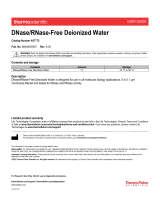 Thermo Fisher Scientific DNase/RNase-Free User guide
Thermo Fisher Scientific DNase/RNase-Free User guide
-
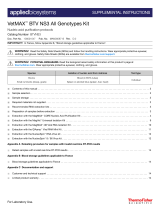 Thermo Fisher Scientific VetMAX BTV NS3 All Genotypes Kit Operating instructions
Thermo Fisher Scientific VetMAX BTV NS3 All Genotypes Kit Operating instructions
-
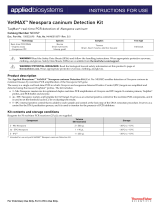 Thermo Fisher Scientific VetMAX Neospora caninum Operating instructions
Thermo Fisher Scientific VetMAX Neospora caninum Operating instructions
-
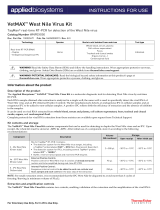 Thermo Fisher Scientific VetMAX West Nile Virus Kit Operating instructions
Thermo Fisher Scientific VetMAX West Nile Virus Kit Operating instructions
-
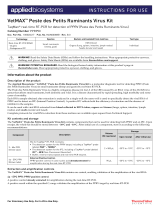 Thermo Fisher Scientific VetMAX Peste Operating instructions
Thermo Fisher Scientific VetMAX Peste Operating instructions
-
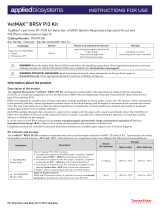 Thermo Fisher Scientific VetMAX™ BRSV PI3 Kit Operating instructions
Thermo Fisher Scientific VetMAX™ BRSV PI3 Kit Operating instructions
-
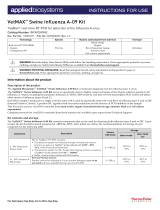 Thermo Fisher Scientific VetMAX Swine Influenza A-09 Kit Operating instructions
Thermo Fisher Scientific VetMAX Swine Influenza A-09 Kit Operating instructions
-
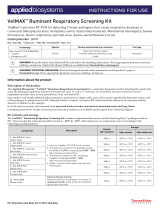 Thermo Fisher Scientific VetMAX Ruminant Respiratory Screening Kit Operating instructions
Thermo Fisher Scientific VetMAX Ruminant Respiratory Screening Kit Operating instructions
-
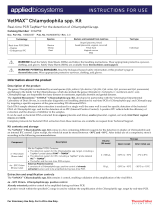 Thermo Fisher Scientific VetMAX™ Chlamydophila spp. Kit Operating instructions
Thermo Fisher Scientific VetMAX™ Chlamydophila spp. Kit Operating instructions















